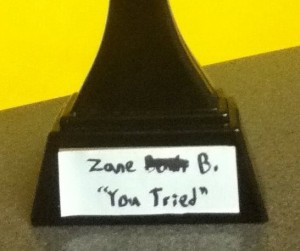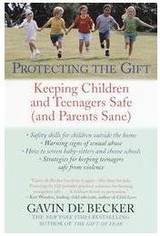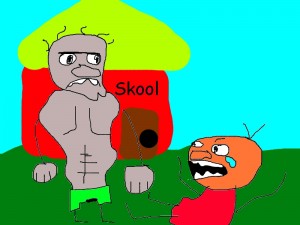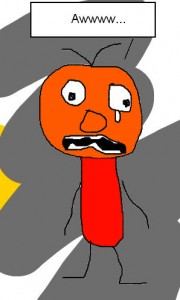So in a continuing effort to bond with my sons and share some of their interests, I sometimes will “challenge” them to video game contests—and by “challenge” I mean that we play some sort of video game where they repeatedly pummel me as I have no clue what the heck I’m doing. In the process, we have a few laughs together over my ineptitude and I like to think it brings us closer together.
If I haven’t mentioned it before, I am not much of a video gamer for the simple reason that it’s waaaay too easy for me to get sucked in, never to be seen again. When I was first dating my wife in the early 1990s (back before I had a computer), I’d find myself over her house spending countless hours playing Wolfenstein and SimCity on her dad’s computer—it’s a wonder she didn’t dump me.
Nonetheless, it became obvious to me that I really can become addicted to it in the blink of an eye. And as one who appreciates the brevity of Life, I’ve decided that I have better things to do than spend my precious time whiling away the hours working a joystick or furiously tapping away at a keyboard. As such, I just avoid them as much as I can, so I’ve never played many of the newer classics, from Angry Birds and Bejeweled Blitz to Draw Something and Candy Crush. Actually, I never played many of the older classics, either—no Mario, no Zelda, no Donkey Kong, no Sonic the Hedgehog … heck, I never even died of dysentery on the Oregon Trail.
Just sad, really.
Anyway, as mentioned, I thought I was overdue for some father-son bonding time, and since it’s about 116 degrees in the shade, an activity that could be done in the comfort of air conditioning seemed like the way to go.
My older son recently got Injustice: Gods Among Us for Xbox from one of his buddies, and I saw him playing it the other day, and it looked like … well, cool. It’s basically a fighting game, stocked with the heroes and villains from the DC universe—Batman, Superman, Flash, Green Lantern, Joker, Catwoman, etc. The visuals are terrific and the game play seems fairly straightforward and centuries beyond any Pong experience that I can recall from the halcyon days of my youth.
In particular, this sequence caught my eye—it’s Aquaman’s “super move.”
Totally cool, right?!!! Anything that can make Aquaman (long derided as being the lamest of super friends) look like a bad ass—and involves feeding opponents to sharks—I’d like to try at least once.
So we started playing and like I knew might happen, I found myself getting sucked in pretty quickly. I’ve rationalized it by saying that I’m spending time with my sons, but really, I’m also really just losing myself in the mindless fun of it.
But as you might expect, my mind never really rests, even when it’s supposed to be playing.
So I thought what this game needs is some special characters—but rather than take them from the DC universe, I thought they could come from the current real universe. Since Injustice sort of has each hero and their arch-nemesis, I thought I’d follow that pattern, too.
As such, here are some characters that could be added.
Barack Obama – Everyone wants to be President of the United States, right? So here’s your chance. Fighting moves include “The POTUS Punch,” “(Medieval) Flail From the Chief” and “The Violent Veto.”
• Super Move: “ObamaFlair,” where the President strolls up to his opponent and just nods casually at them—a detachment of Secret Service agents appear and beat down the opponent, leaving them bleeding in the middle of the screen. An unmanned aerial drone then comes screaming in and unleashes a firestorm of missiles, completely vaporizing the opponent.
Donald Trump – The nemesis of Obama, and the working poor, too. Fighting moves include “The Birth Certificate Shakedown,” “The Trump Thump” and “The Uptown Lowdown.”
• Super Move: “The Toupée Flambé,” where The Donald’s limo first runs repeatedly over the opponent, and after they are beaten down, Trump jumps out of the back seat, yanks off his bad hair and shoves it into his opponent’s throat until they are choking. He then lights a $100 bill, holds it dramatically, then touches it to the toupée, which bursts in a white-hot flame that torches his opponent. He then stands over them, laughs and says, “You’re fired!”
Charles Ramsey – Sure, his 15 minutes of fame for helping to rescue three women being held hostage in Cleveland might be up, but that doesn’t mean he can’t be immortalized in a video game. Fighting moves include “Kick It Down,” “The 15-Minute Firestorm” and “Cleveland Rocks.”
• Super Move: “The Big Mac Attack,” where Ramsey stuns an opponent with a door, then stuffs burgers down his opponent’s throat until they bloat up and explode, resulting in pickles, lettuce, tomatoes and ground beef (human and cow) to rain down.
Rush Limbaugh – The nemesis of Ramsey and non-whites everywhere. Fighting moves include “The Mega Ditto Mash,” “The Racist Ramble” and “The Bully Pulpit.”
• Super Move: “The Pill Popper,” where Limbaugh first sits on the head of his opponent, causing them to become weak, and as they stumble around, Limbaugh reaches inside his jacket, takes out a giant vial of pills, pops them into his mouth and then spits them out like machine gun bullets, tearing his opponent to shreds.
Chris Kluwe – The well-spoken punter of the Oakland Raiders, a huge World of Warcraft aficionado who grabbed headlines by sending a scathing open letter defending gay marriage to ignorant Maryland state delegate Emmett C. Burns Jr. Fighting moves include “Dropkick to Homophobic Balls,” “Necessary Roughness” and “Hero Spell.”
• Super Move: “The Death Punt,” where Kluwe whips out his WoW sword and severs his opponent’s skull, which he then grabs and kicks across the Injustice world—leaving a gay pride rainbow in its wake—and through a fiery goal post at the other end. After it explodes, Kluwe just nods his head while Andres Cantor’s screams “Gooooooooool!!!!”
Fred Phelps – As the leader of the infamous Westboro Baptist Church, he is the scourge of intelligence and decency everywhere, and a natural nemesis of Kluwe. Fighting moves include “Haterade Parade,” “Attention Whore Galore” and “Prince of Lies.”
• Super Move: “The Picket Line,” where Phelps points at his opponent and screams “Heathen!” which summons forth his inbred followers to do his dirty work that includes beating his opponent senseless with their handheld signs. When woozy, he then calls in his pack of lawyers, who feast on the opponent and tear away his flesh like a hungry jackals while Phelps basks in the glow of heavenly light.
Matt Harvey – The Connecticut-born ace of the New York Mets pitching staff, a.k.a “The Dark Knight of Gotham.” Fighting moves include “The Mystic Warrior,” “Flamethrower” and ”
• Super Move: “Strike Three!” where Harvey scorches three flaming baseballs by his opponent simultaneously, which set the opponent on fire. The opponent instantaneously burns to a crisp and crumbles into a pile of ashes, which are casually swept up by an umpire.
Alex Rodriguez – “A*ROID,” admitted steroid abuser and MLB cheater, is the antithesis of Harvey and all the players who compete by the rules. Fighting moves include “The Grand Slam,” “Phony Baloney” and “The Big Choker.”
• Super Move: “Roid Rage,” where Rodriguez grabs a giant hypodermic needle and sticks it in his opponent’s butt—his opponent immediately sprouts zits on their back, his testicles shrink and he starts to swell up with muscles (like Violet in Willy Wonka and the Chocolate Factory). Rodriguez then grabs a bat and hits them, causing them to explode.
Melissa McCarthy – The full-figured, humble and hugely talented star of TV and movies. Fighting moves include “The Badonkadonk Beatdown,” “Box Office Boffo” and “The Laugh Factory.”
• Super Move: “The Gut Buster,” where McCarthy makes her opponent watch her clips, getting them to laugh harder and harder … at first they pee themselves, then they get hiccups, and finally, they just split a gut—literally—and bleed out, expiring with a smile on their face.
Justin Bieber – A scrawny teenaged heartthrob who may have had aspirations of being a genuine entertainer but is quickly becoming just another Hollywood douchebag. Fighting moves include “The Pin Up,” “The Twitter Splitter” and “Beauty and a Beating.”
• Super Move: “Bieber Fever,” where Bieber stops the fight, pulls out a cell phone and Tweets something. Suddenly, a hook drops from the ceiling and the doors of the fight arena open simultaneously; Bieber grabs on to the hook and ascends while thousands of screaming teenaged girls flood in through the doors and, deprived of a chance to be with Justin, attack the hapless opponent just standing there, literally tearing him from limb to limb.









